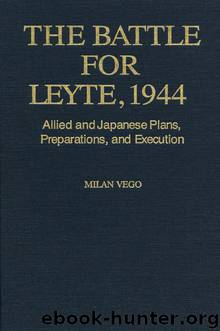The Battle for Leyte, 1944 by Vego Milan;

Author:Vego, Milan; [Vego, Milan]
Language: eng
Format: epub
Publisher: Naval Institute Press
Intelligence Estimates
SWPA and POA intelligence used information it had collected from the various aircraft sightings, submarine reports, and Magic intercepts to provide input for the decisions made by Allied commanders. Much of the intelligence produced by GHQ, SWPA, dealt with ground and air intelligence. Naval intelligence was produced by the Seventh Fleet staff and CINCPOA and Third Fleet staffs. Common to all was a reliance on enemy intentions rather than his capabilities. The result was that it was not recognized until too late that the movements of far-flung Japanese forces toward Leyte were converging at a single spot: Leyte Gulf.
The GHQ G-2’s estimate of enemy naval intentions for 23–24 October included a report that two forces, one including three battleships and the other consisting of 26 unidentified ships, were observed in the Sibuyan Sea. Intelligence analysts believed that the enemy force could proceed through the San Bernardino Strait in an attempt to attack Allied forces at Leyte from the north. Significantly, however, no carriers had been reported in either of these sightings. This left open the possibility that the enemy carrier force could be deployed off Luzon’s east coast to support attacks by enemy surface forces converging on the Leyte area. GHQ’s intelligence analysts believed it was more probable that enemy carriers would be deployed near Mindoro to strike targets in the central Philippines by possibly staging carrier aircraft through land bases in the Visayas.28
The SWPA’s intelligence believed that the enemy’s minimal activity might indicate that he would mount a relatively strong air attack against Allied naval forces, possibly in support of a naval engagement. One indicator supporting that assumption was that enemy efforts against Allied naval ships had been meager to date, probably because the Japanese wanted to preserve the major part of their air strength for conducting a series of attacks at a propitious time. Another indicator was that the enemy air strength in the Formosa-Philippines area was increased from 204 bombers and 264 fighters on 19 October to 307 bombers and 328 fighters two days later. This figure did not include carrier-based aircraft and a possible presence of about 200 aircraft at Puerto Princesa (Palawan).29
The GHQ G-2’s analysts noted that while the possibility of the enemy’s strong air reaction could not be ignored, there were some factors that made it unlikely. They cited the factor of poor training of a large part of enemy carrier pilots, due in great part to large losses of pilots suffered in the battle of the Philippine Sea in June and air battle off Formosa in mid-October 1944. In addition, most enemy aircraft from major bases in Formosa, Palawan, and Luzon had to stage in the Manila-Clark, Negros, or Bicol airfields, thus coming within easy range of Allied carrier-based aircraft. Analysts also highlighted that during the past six weeks the enemy had employed only about 250 to 300 aircraft in defense of his vital installations. In their view, this was a good indicator for measuring possible enemy efforts in the future. In
Download
This site does not store any files on its server. We only index and link to content provided by other sites. Please contact the content providers to delete copyright contents if any and email us, we'll remove relevant links or contents immediately.
| Automotive | Engineering |
| Transportation |
Whiskies Galore by Ian Buxton(41669)
Introduction to Aircraft Design (Cambridge Aerospace Series) by John P. Fielding(32979)
Small Unmanned Fixed-wing Aircraft Design by Andrew J. Keane Andras Sobester James P. Scanlan & András Sóbester & James P. Scanlan(32648)
Craft Beer for the Homebrewer by Michael Agnew(18036)
Turbulence by E. J. Noyes(7846)
The Complete Stick Figure Physics Tutorials by Allen Sarah(7223)
Kaplan MCAT General Chemistry Review by Kaplan(6752)
The Thirst by Nesbo Jo(6665)
Bad Blood by John Carreyrou(6416)
Modelling of Convective Heat and Mass Transfer in Rotating Flows by Igor V. Shevchuk(6313)
Learning SQL by Alan Beaulieu(6123)
Weapons of Math Destruction by Cathy O'Neil(6019)
Man-made Catastrophes and Risk Information Concealment by Dmitry Chernov & Didier Sornette(5828)
Digital Minimalism by Cal Newport;(5538)
Life 3.0: Being Human in the Age of Artificial Intelligence by Tegmark Max(5336)
iGen by Jean M. Twenge(5263)
Secrets of Antigravity Propulsion: Tesla, UFOs, and Classified Aerospace Technology by Ph.D. Paul A. Laviolette(5190)
Design of Trajectory Optimization Approach for Space Maneuver Vehicle Skip Entry Problems by Runqi Chai & Al Savvaris & Antonios Tsourdos & Senchun Chai(4921)
Electronic Devices & Circuits by Jacob Millman & Christos C. Halkias(4828)
